chainflex® works or your money back!
The tricks and ingenious features of the Chainflex® design and why we feel so confident about this design
From the customer's point of view, a flexible energy supply system only needs to function properly. However, this demand presupposes the perfect operation of all components, including the cables being used in this system. And this is exactly where problems came up in the early 1980s. Due to constantly – and frequently even tremendously – increasing loads resulting form the application of automation technology, guided cables often failed although the energy supply system itself was functioning perfectly. In extreme cases, failures caused by "corkscrews" and core ruptures brought the entire production process to a standstill and resulted in high costs. In order to find a solution to this unsatisfactory situation for its customers, igus® decided to take the initiative. As the first company worldwide, igus® began to develop complete Energy Chain Systems®. Chainflex® cables and Energy Chains® are now being offered as a delivery from a single source and with a system guarantee depending on the application in each case. Based on the increasing know-how gained since 1989 and on the very sophisticated series of tests that have been conducted since then, design principles were and are still being created that help prevent machine downtimes in factories throughout the world today.
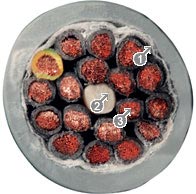
Picture 1: Chain-suitable cable stranded in layers
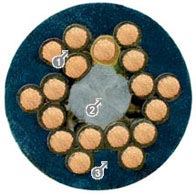
Picture 2: Litz wire and core structures of a Chainflex® cable
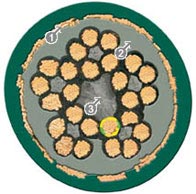
Picture 3: igus® stranding in bundles around center cord
Fleece
2Extruded, non-tension-proof center element
3Cores braided in layers
Single-wire bundles with short pitch lengths
2Center element for high tensile stresses
3Highly abrasionresistant, gussetfilled extruded jacket
Total shield with optimized braiding angle
2Gusset-filling extruded inner jacket
3Center element for high tensile stresses

Picture 4: Shielded "chain-suitable" control cable after only 400,000 to-and-fro cycles with a bending factor of 10 x d
Here, the term "corkscrew" does not refer to a useful instrument for wine connoisseurs. Instead, it refers to the permanent deformation of guided, moved cables caused by excessive stressing – which, in most cases, results in core rupture almost immediately afterwards. How does this happen? How can "corkscrews" be prevented? An important factor here – in addition to a sensible design of the total Energy Chain System® – is the construction of the guided cables. Basically speaking, a clear distinction can be made between cables stranded in bundles and cables stranded in layers.
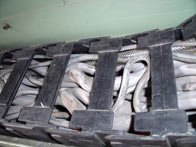
Damaged cable in an energychain
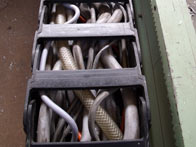
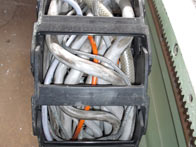
Properties of stranding in layers
Stranding in layers is significantly easier to produce and is therefore offered on the market in so-called "chain-suitable" cables at low cost. But what appears to be tempting at first glance can quickly turn into an expensive mistake when a "corkscrew" immobilizes the system being operated with these cables. How do these problems arise? A look at the cable structure can be quite helpful (see picture 1). In the case of stranding in layers, the cable cores are mostly stranded more or less firmly and relatively long in several layers around a center and are then provided with a jacket extruded to the form of a tube. In the case of shielded cables, the cores are wrapped up with fleece or foils. But what, for example, happens to a similarly structured 12-core cable during normal operation? The bending process compresses, in the movement of the core, the inner radius of the cable and stretches the core in the outer radius. Initially, this works quite well because the elasticity of the material is still sufficient. But very soon, material fatigue causes permanent deformations, and then, due to excursion from the specified paths, the cores make their "own compressing and stretching zones": The corkscrew is created, then followed rather quickly by core ruptures most of the time.
Stranding in bundles tried and tested expensively and efficiently millions of times since 1989
Stranding in bundles eliminates these problems by means of its very
sophisticated, multiply stranded internal structure. Here, the litz wires are
stranded with a special pitch length first and then the resulting cores are
stranded into single core bundles. For large cross sections, this is done
around a strain relief element. The next step is the renewed stranding of
this core bundle around a tension-proof center – a genuine center cord.
Due to this multiple stranding of the cores, all cores change the inner radius and the outer radius of the bent cable several times at identical spacing distances. Pulling and compressing forces balance one another around the high-tensile center cord that gives the stranded structure its necessary inner stability. Accordingly, the stranding remains stable even under maximum bending stress.
What are EMC problems and shield wire breakage?
In principle, cable shields must fulfil two tasks:
Protecting the cables from external interferences
Shielding any interferences before transmitting them to the outside
Both tasks are equally important because faulty signals can cause considerable consequential damage in the system itself as well as in any external systems. Furthermore, this is an especially problematic point due to the fact that incorrect shielding usually cannot be detected from outside, and this is something that makes the trouble-shooting procedure extremely difficult. How can these kinds of problems arise in the first place?
Once again, the answer is to be found in the internal structure of the cable itself: Is the shielding designed for the movements of the cable? Although it may be very easy to shield a fixed cable, it is much more difficult to
guarantee the permanent shielding of a moving cable.
In the case of so-called "chain-suitable" cables, for example, the stranding bond of an intermediate layer is wrapped up with foils or fleeces. This stranding bond is supposed to guarantee the separation between
the cores and the shield braid. But something that functions quite well for the fixed installation of cables is often quite insufficient in the case of moving cables. This has to do with the fact that the foils and fleeces do
not create a bond between the stranding, shield and jacket and may fall apart under stress. Consequently, the metallic shield then rubs on the insulation of the cores – short circuits are then to be expected. But the production of the shield itself is very time-consuming and
cost-intensive and may have been the reason for the use of open braid shields or even simple wire wrappings. The disadvantages are quite obvious: Open shields only possess a limited shielding effect in their
moved state – motion and expansion reduce this effect even further. The type of shield is therefore an important point that is not even mentioned in some catalogues.
In its up to approx. 70% linearly and approx. 90% optically covered cables, igus® eliminates these weak points by means of an optimized internal
structure. In virtually all shielded Chainflex® cables, a gusset-filled extruded inner jacket over the stranded structure is therefore used. This "second
jacket" fulfils two tasks:
It holds the stranded structure together and guides the individual cores as in a channel.
It serves as a firm, round base for a very tight-fitting shield.
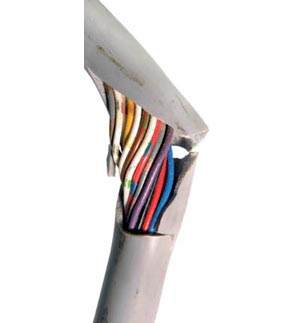
Jacket breakage at (36x0.142) after only 900,000 to-and-fro cycles with a bending factor of 7.8 x d
Shield wire breakage – and how this can be prevented
And even during the production of the shield, there are many things that can be done correctly – or incorrectly. The braid angle is an important parameter here. In the so-called "chain-fit" cables, a tensile load of the shield wires in the cable's outer radius is usually expected. If the braid angle is adverse in addition, the tensile load increases further and shield wire breaks can occur. The consequences range from reduced shielding effect to short circuits, if pointed wire ends pierce the cores through the webs or films. Important notice: When the shield can be easily slid over the jacket after the stripping, the shield is already unsuitable for moving energy supply systems in most cases! igus® counters that in a targeted manner:
The shield braid angle determined by long-term trials securely neutralizes the tensile strengths and is therefore ideally suited for E-Chains®.
Due to the stable inner jacket, the shield cannot wander uncontrolled.
The shield itself exerts torsion protection on the braid.
Jacket abrasion/ jacket breakage
Whereas defects in the internal structure are hardly detectable on the outside, jacket problems strike the eye immediately. The jacket is the first protection for the complicated internal structure. This is why broken, worn and swollen jackets are a serious quality defect. To prevent this problem, the igus® customer can select among 7 acket materials to adapt his Energy Chain® cables to suit the conditions of the respective environment.
Gusset-filled extruded jacket
Here, not only the material is an important factor but also the production process. In the case of the so-called "chain-suitable" cables, the jackets are usually produced extruded to the form of a tube and therefore do not provide the stranded structure with the necessary support for constant bending processes. The stranded structure
can fall apart.
Therefore, igus® is the first manufacturer of Energy Chain Systems® to offer the so-called the "gusset-filled extruded" jacket.
Here, the jacket material is injected between the core stranding
powdered with talc and ensures that the stranded structure does not open up and also makes sure that the cores are guided as in a channel. The special characteristic of this type of production is that the intermediate spaces, which are created between the cores during the stranding process, are completely filled with jacket material by the high extrusion pressure. As a result, the jacket material creates a channel-like guide which allows the cores to carry out a defined longitudinal movement. The jacket also provides a supporting function for the stranding.
The quality bundles of igus® Chainflex® cables
Strain-relieving center
Stranding in bundles
Gusset-filled extruded inner jacket in shielded cables
Enclosed shield braid
Optimized shield braiding angle
Gusset-filled extruded jacket
More than 100,000 products available! Delivery and consultation Mon-Fri from 7am-8pm and Sat from 8am-12pm!